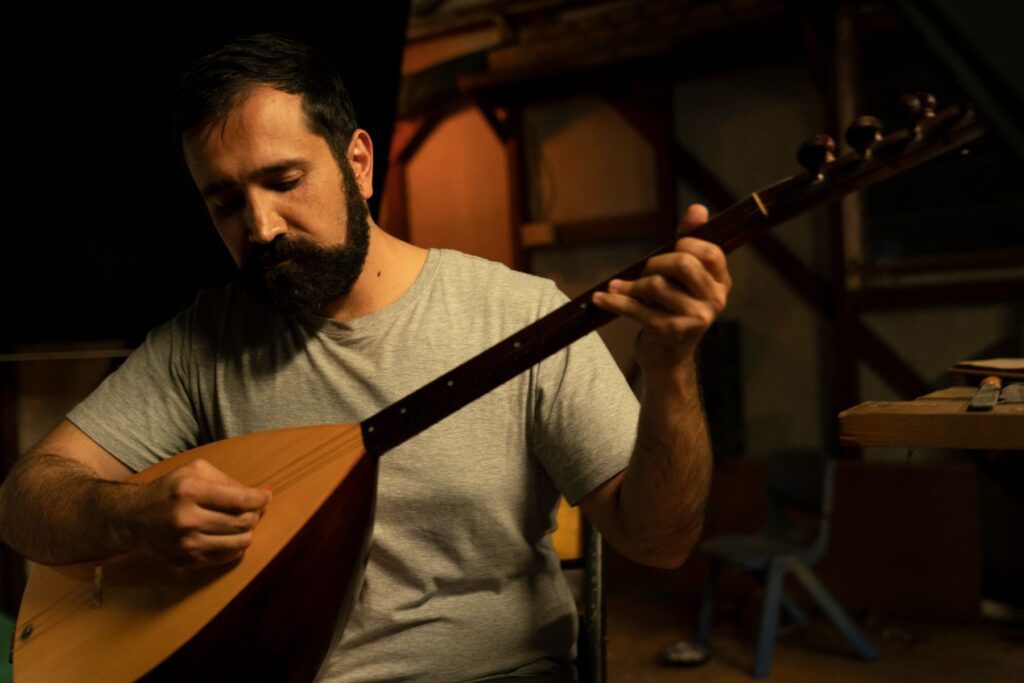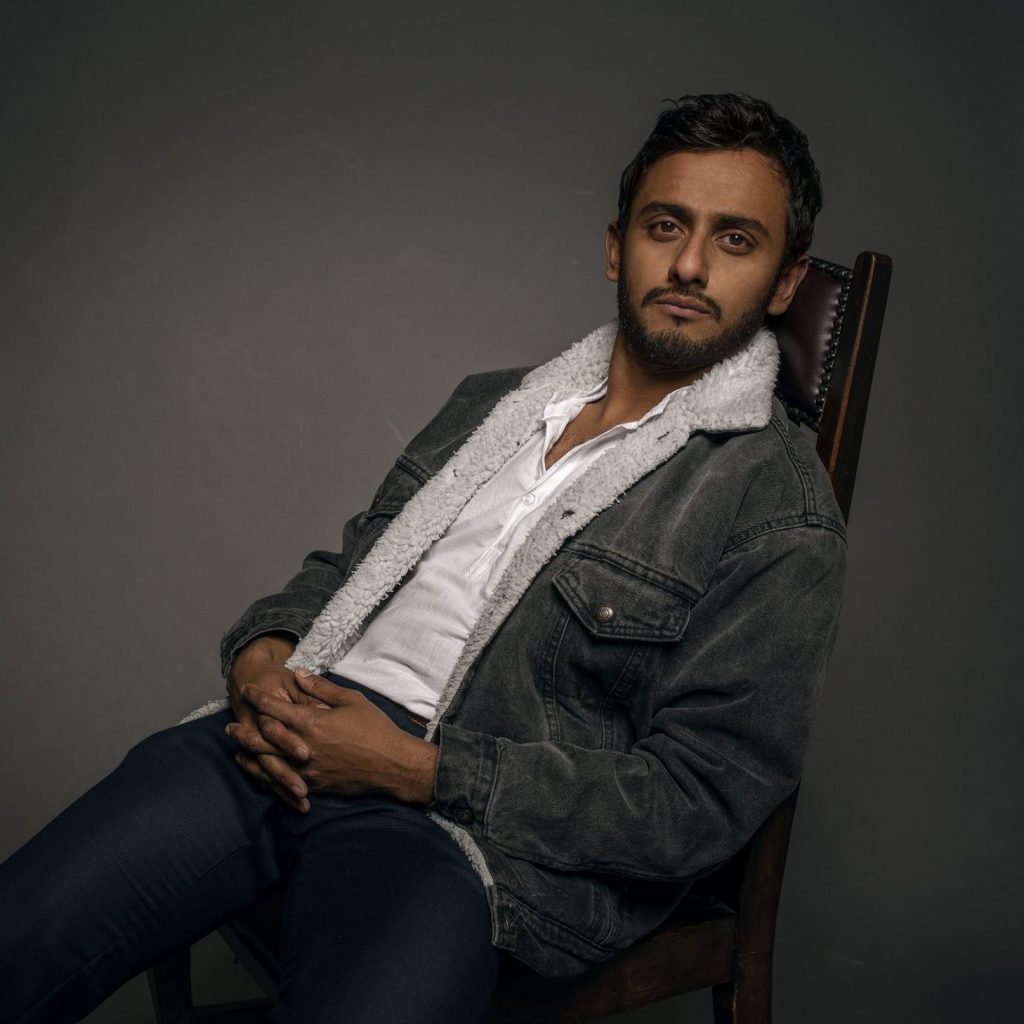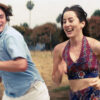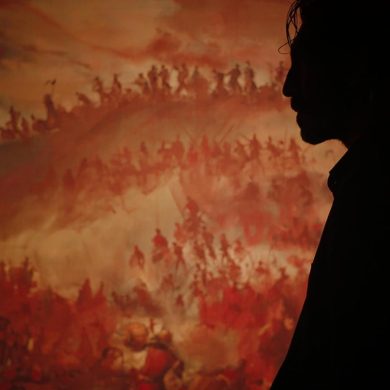Here Out West will be available in cinemas February 3 and will air on ABC later this year.
There’s a thrill that goes through the heart of a Sydneysider when this most beloved infuriating city appears onscreen, when the camera moves over the glass and steel centre and across the dizzying sprawl of suburbia. I was coming back on a plane once, a young girl was in the middle seat beside me, and it suddenly occurred to me it was probably her first-time landing in Sydney. When we started the descent, I said with magnificent generosity, “Lean over and look through the window.”
We flew down through layers and layers of cloud, through so much swirling mist of rain, and then the infinite glittering disarray burst into view, including that bloody hideous pink building on Parramatta Road. I will never forget her gasp. The exact shock and delight I feel every time I come home.
That thrill is made a little more delicious in the opening frame of Here Out West because for once, the introductory view of Sydney is not any of the usual tourist tropes. Instead it’s the circle and intricate network of motorways with the smoggy city line in the far distance. It tells you immediately that this is not your typical film with all the glossy unreal imagery of a Sydney most of us can’t afford and haven’t even driven through.
But neither is it a film that goes in the opposite direction of grime and darkness and brutality. Nah thanks, mate, not here, not now. As the camera moves over the clean cool busyness of Western Sydney industrial and suburban scapes, the images are familiar and all the more endearing for being onscreen.
That opening shot of intricate interlinked motorways is a nice metaphor for the structure of this anthology film: eight stories that weave in and out of each other with an overarching plot. A grandmother steals her newborn grandchild from a Western Sydney hospital, and these are the stories of people who cross her path during that one day.
The dramatic through line recedes every now and then, but feels forgivable because it focuses attention on the small fascinating drama in the fore. Some of the stories are a little baffling, some are more interwoven than others which is both rewarding and relaxed viewing. In one, cliches are set up and then subverted to wicked effect, exposing our own prejudicial assumptions. In another, cliches are roundly challenged from the start and fought over until destroyed.
There’s a richness to each story: sometimes it’s overt and pushes up hard from under the text. Sometimes it’s for you to bring all your knowledge of that particular cultural history and understand the layers to the story unfolding onscreen. The weight of inherited generational trauma reappears in so many families, sometimes the memories of the physical journey from where they had to leave to where they are now, a story told and retold over and over again. There’s so much nuanced depiction of the intricate negotiation each person has to manage between private home and public arena, between the demands of family and self-actualisation, the uncertainty of whom to trust in this new country compounded sometimes by the indignity of your own people tearing you down. There is the grief of generational disconnect, of relinquishing the past, and the grief of being parted in the present, of sacrificing one future for another to safeguard a family.
None of this stuff is new to those of us who are first, second, third generation migrants. Some of us know our family history better than others but we all feel the effects. And it makes such a weird wonderful difference to see that onscreen, acted out by people who look like us and sound like us with our hybrid or fully Strine accents, people who code-switch like we do, slipping between behaviours and languages with ease or awkwardness.


We, The Spiders – Director: Lucy Gaffy – Writer: Nisrine Amine – Language: Arabic
Everything Changes – Director: Ana Kokkinos – Writer: Matias Bolla – Language: Spanish
Brotherhood – Director: Leah Purcell – Writer: Arka Das – Language: Bengali
The Eternal Dance – Director: Ana Kokkinos – Writer: Bina Bhattacharya –Language: Bengali
The Musician – Director: Fadia Abboud with the assistance of Ana Kokkinos – Writer: Dee Dogan – Language: Kurdish, Kurmanji
Brother Tom – Director: Fadia Abboud in collaboration with Ana Kokkinos – Writer: Tien Tran – Language: Vietnamese
The Long Shift – Director: Julie Kalceff – Writer: Vonne Patiag – Language: Tagalog
Closing Night – Director: Leah Purcell – Writer: Claire Cao – Language: Cantonese
The eight stories each have their own writer and frequently their own language. All up, there are more than eight languages spoken in the film, and together they form a potent theme. Written language connects father and son, spoken language divides father and daughter, forbidden in the workplace and used anyway in shared rebellion, connects friends across race, and connects strangers in moments of need. The mockery of language is used by one character to humiliate himself to his arsehole white overlords in a moment of hair-raising effect, and his eventual assertion of dignity is through crisp sparse speech. (Reader, I cheered.) I particularly loved how translation is used as a plot device in one story and made part of family history in another.
The use of subtitles is thoughtful: timed and withheld and provided to serve the storytelling. A song is sung subtitle-free in a sequence that feels so private and specific, keeping us at a respectful distance. If you know, you know; if you don’t, it’s not for you. I thought that, and then scrutinised the closing credits and squealed quietly to myself. The song is linked with lovely deliberation to the name of a character. That’s some damned fine writing.
It cannot be easy to score an anthology feature, and Amanda Brown’s score is no doubt the result of close collaboration with the writer-producers and the directors of each segment. It’s a score that immediately juxtaposes Eastern melody with Sydney visual in the opening credits, thrumming with life, flagging that this is not your tired old whitebread Australian narrative. The soundtrack very quickly establishes the energy and aesthetic of each new tale – masculine momentum or assertive girl punk – and then withdraws right back to the most delicate sounds for a delicately drawn narrative around a musician. Again, the closing credits make for some fascinating hints at the production process.
Five female directors divide the eight stories between them. Personally, I would have liked the writer and director credits with each story title in that subtle elegant font, but I understand not everyone is like me. Lucy Gaffy has the difficult task of setting up the anthology and does it with deft economy, letting Genevieve Lemon dominate the screen with realness. Unsurprisingly, Leah Purcell’s two segments are the most bold and energetic, with vibrant characterisation and a delightful canvassing of so many different urbanscapes. Ana Kokkinos’ two solo efforts are explorations of grief: one very poetic and ephemeral, and the other exactly the complex skilful storytelling I would expect from such a powerhouse of Australian cinema.
The two stories directed by Fadia Abboud (with assistance/collaboration from Kokkinos) are remarkably different in tone, moving from unease and unutterable poignancy in one to clashing personalities and ironic reconciliation in the other. Julie Kalceff’s light touch makes her narrative feel so much like the fully engaging first act of a really good movie that I was caught totally off-guard when it ended and got quite cross for a moment. And yes, at least two of the vignettes ought to be made into full feature films, thank you.
Also, look out for some of the writers sneaking in as extras in their respective sequences. Nisrine Amine in the car pulling out of the driveway, Matias Bolla at the game, Vonne Patiag on the bus right behind his protagonist. Don’t worry, you won’t – and shouldn’t – miss Arka Das. In a rather multifaceted performance, he has a moment of incredible silent eloquence, so much subtext in the flicker of his eyes, and then a later moment of beautiful subtle resolution.
Overall, the acting calibre is high. Some performances didn’t quite work for me, but there were far more that did, and those were riveting. It’s always a thrill when Rahel Romahn appears onscreen, and it’s particularly lovely to see him get to be sweet rather than angsty though there is a bit of that too. The abrasive tenderness between him and Thuso Lekwape and Arka Das is easily a highlight of the film. Another is the immense gentleness of De Lovan Zandy’s performance.
Leah Vandenberg does not come to play – she absolutely nails the fraught complexity of a daughter negotiating a deeply emotional rite of passage, a woman of so many textures inhabiting so many subcultures at once. This is an actor totally in command of her material and her craft. I felt quite choked up, watching her intensity and remembering the clever girl she was in Erskineville Kings (2000).
A fantastic combination is Gabrielle Chan and Jing-Xuan Chan in two wonderfully fiery performances full of so much heart and humour and clashing wills. Also worth mentioning is Anita Hegh who moves like a glacial-eyed shark through a few stories, and is frankly terrifying until she reveals unexpected sympathy.
The cinematography by Tania Lambert is unobtrusive but no less pleasing to the eye. The colour-grading is particularly impressive: soft golds for private spaces, cold greys and blues for hospital corridors; the vibrant pop of red carried by a character. Western Sydney isn’t depicted as an endless hot hellscape – there are clean cool colours, soft dusk shades, neon streets, parched sunlit greenery, a howl of graffiti on a fence. It’s a landscape as varied and interesting as its communities, as visually multifaceted as the rest of Sydney, crossed and linked by those modern motorways.
Sure, there are more stories that could have been told in this anthology. There’s only one Black character and he never gets to tell his own family history. Unless I was reading too much into one character, there’s no obvious First Nations representation onscreen in this Australian feature. But that’s why the production company Co-Curious exists, to bring more stories like this to screen and stage.


Co-Curious supports writers from underrepresented backgrounds to develop and deliver rich culturally significant stories demonstrating the lived experience of contemporary Australia. Established in 2018 with the support of Screen Australia and Create NSW, the company has since carved out a reputation as an innovative and collaborative arts company that invests in writers. Our model strives to create two-way learning and deeply embeds writers at the heart of our productions. Our focus is both content development and programs which include workshops, mentorships and placements designed to develop the professional skills of the participants and prepare them for industry careers.
Here Out West is a film brave enough to choose tenderness over grittier modes of narrative. Equally, it could have fallen into mawkish cliches, taken the candy superficial way through all these stories. But it never does. The care shines through in the depth of the writing, in the time given to small moments and quiet moments, in the dignity of characterisation, in the beauty of its cinematography and score, in the unshakeable unpretentious quality of the acting. It may have tiny flaws but watching this feels like welcoming a valuable and long overdue addition to the Australian film canon.
Mate, this is Straya, too. More of this, please.
Directors: Fadia Abboud, Lucy Gaffy, Julie Kalceff, Ana Kokkinos, Leah Purcell
Cast: Leah Vandenberg, Arka Das, Rahel Romahn, Brandon Nguyen, Nisrine Amine, Jing Xuan Chan, Anita Hegh
Writers: Nisrine Amine, Bina Bhattacharya, Matias Bolla, Claire Cao, Arka Das, Duygu Dogan, Vonne Patiag, Tien Tran
Producers: Annabel Davis, Sheila Jayadev, Bree-Anne Sykes
Score: Amanda Brown
Cinematography: Tania Lambert
Editorial Department: Basia A’Hern (Post Producer), Catherin Armstrong (Head of Post Production), Veronica Buhagiar (Assitant Editor), Becky Evans (Assistant Editor), Jamie Hediger (Colorist)
Script and Continuity Department: Blake Ayshford (Script Producer), Michael Wray (Script Supervisor)







